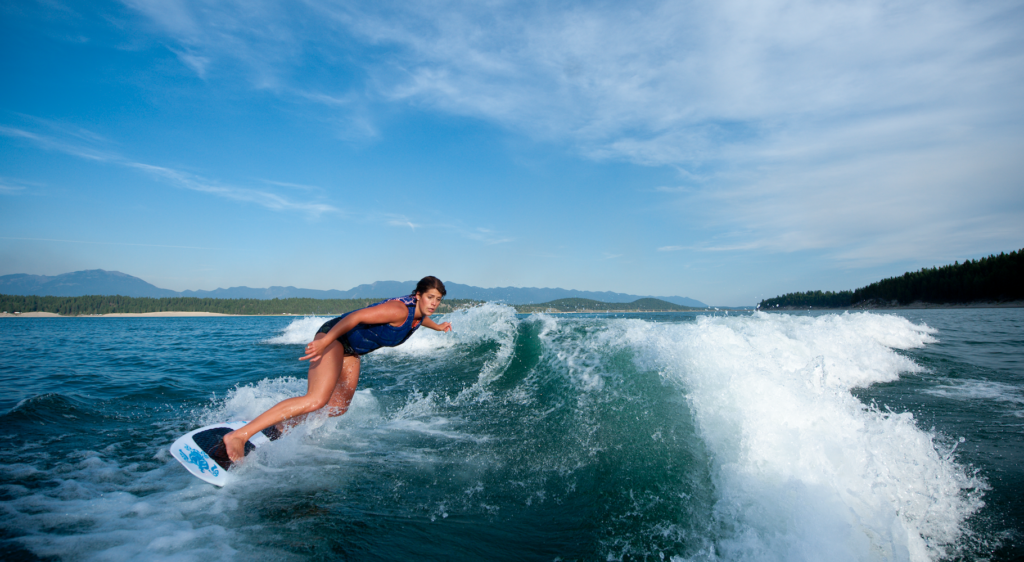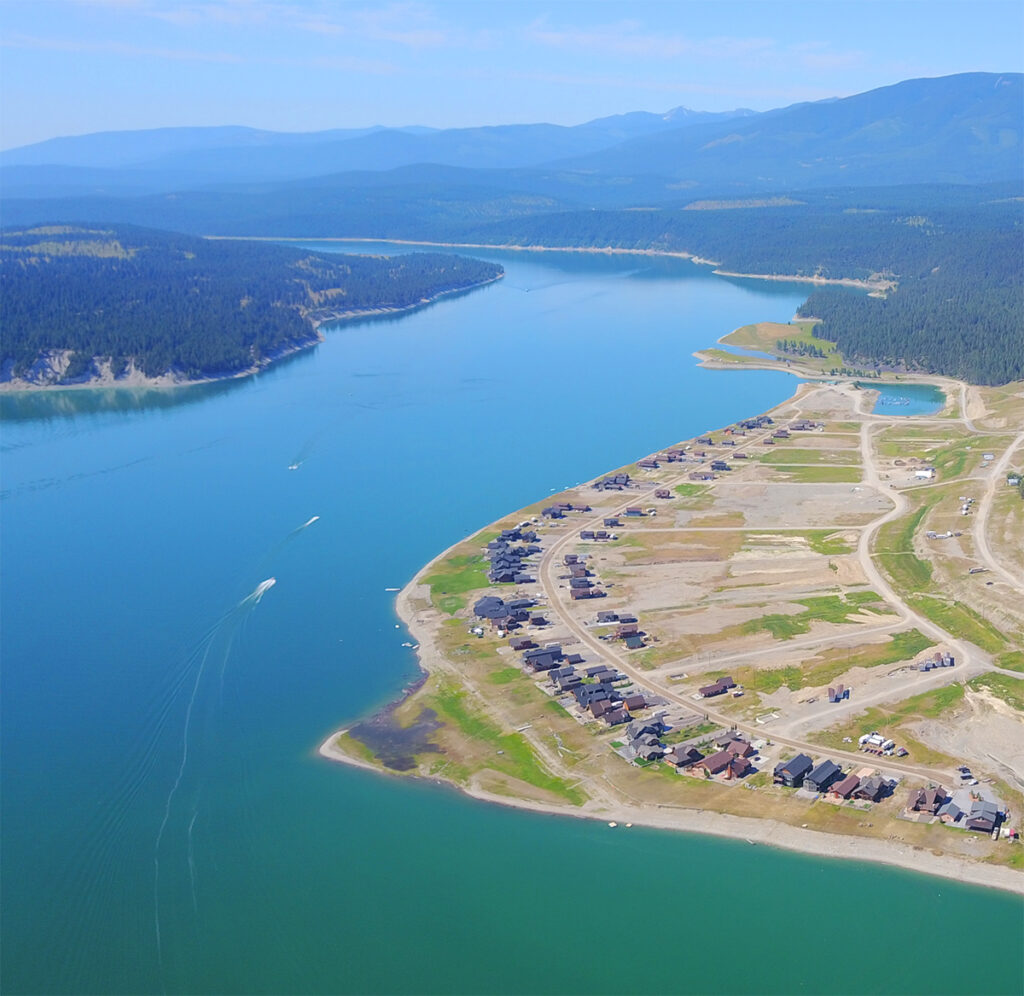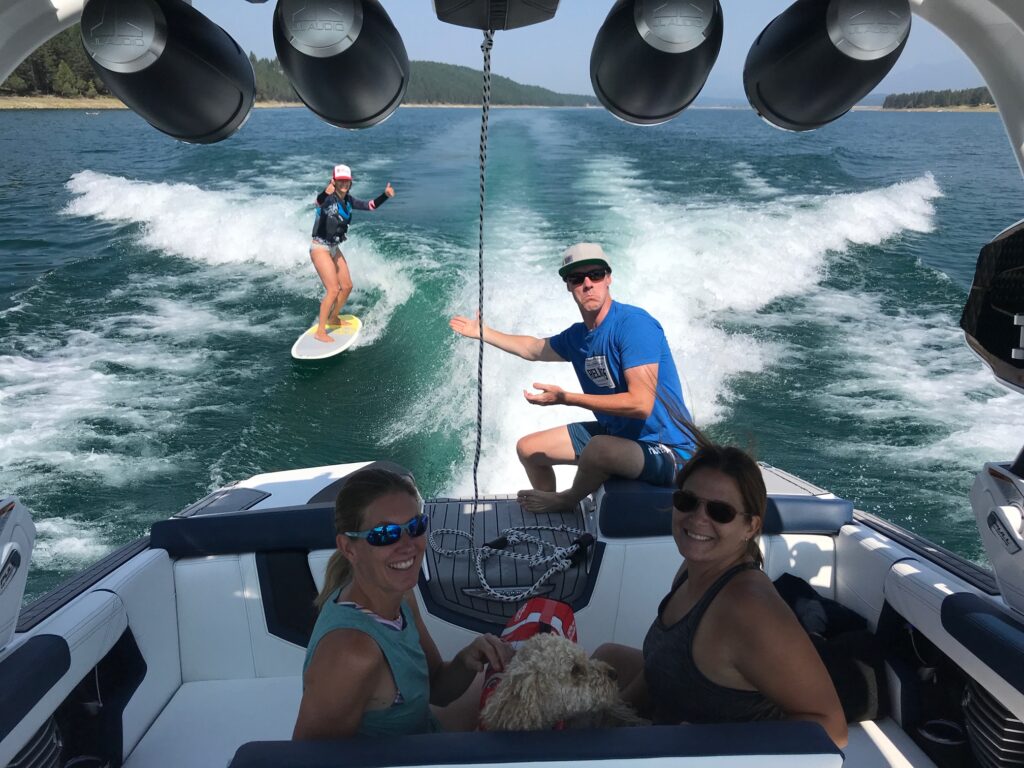
Accoring to Wikipedia wakesurfing is a water sport in which a rider trails behind a boat, riding the boat’s wake without being directly pulled by the boat. After getting up on the wake, typically by use of a tow rope, the wakesurfers will drop the rope, and ride the steep face below the wave’s peak in a fashion reminiscent of surfing. Wakesurfers generally use special boards, designed specifically for wakes.
To which we say, bring on summer!
Lake Koocanusa = miles of uninterrupted still water, perfect for all levels of wakesurfers

Whether you’re a novice rider or a seasoned pro, there’s no better place to scratch your wakesurfing itch than on glassy Lake Koocanusa. With plenty of uninterrupted lake real estate you’re guaranteed space where can enjoy your own wake — avoiding the crush and residual waves from neighbouring boats in too-cramped spaces, where safety can also be a major concern.
Did you know that Lake Koocanusa offers 145 km of shoreline and summer water temperatures averaging 25.5 C?

“Wakesurfing on Lake Koocanusa is definitely a favourite summer pastime for our entire family,” said Jo Williams. “We love this lake because there’s so much room — we don’t feel cramped, which is really important when you have a mix of ages and abilities and want to ensure the safety of your family.”
“It’s also one of the best ways to entertain guests,” says Williams. “I can guarantee that our summertime visitors mark this down as one of their top activities when visiting.”

New to the sport? Check out this post for a step-by-step guide on getting started with wakesurfing.

A-Frame: A term used to describe a slider or rail that has an up rail, horizontal rail, and down rail that makes the shape of the letter “A”.
Air: Getting in the air, the amount of space between the rider and the water.
Air Trick: A trick performed using line tension for lift instead of the wake.
Backside Boardslide/Lipslide: A Boardslide or Lipside where the rider approached the slider or wake with their back closest to the object being used.
Backside Spin: A spin where the rider rotates with the back of their body towards the boat first. For a left-foot forward rider this would be clockwise. Sometimes mistakenly referred to as a “blindside spin”.
Blind: Landing blind is also like landing wrapped, where the rider does not pass the handle so they land with the handle behind their back with their back facing the boat. Referred to like a “Tantrum to Blind”, or “Front Flip to Blind”. Sometimes backside spins are mistakenly referred to as “blind” spins.
Boardslide: A slide on an obstacle or wake where the nose of the board is what travels over the obstacle. So if you approache a slider with your chest facing it and ollie up and slide with the nose over the slider, it’s a Frontside Boardslide.
Bone: To bone out a grab or bone out your leg means you straighten it all the way out. So I “boned out grab” is one where your leg or legs are straightened out while grabbing.
Bonk: The act of touching/hitting your board on an obstacle. If a rider “bonks a buoy”, they’re hitting their board agains the buoy briefly.
Bunny Hop: Another term for Ollie. Bunny Hop comes from world of BMX biking, while Ollie is a term from skateboarding.
Butt Check: When the rider lands a trick and drags or slaps their butt on the water. Generally this is considered a sloppy landing.
Butter: A term used for smooth water.
Case: To “case” the wake means to land right on top of the wake in an abrupt fashion.
Choppy: A word used for rough water.
Continuous Rocker: When the rocker of a board is continuous, meaning it has no flat spot in the center of the bottom of the board. This usually makes for a smoother pop and landing, but not as abrupt or vertical of a pop.
Corked Spin: Another name for an off-axis spin. When a rider spins and the rider leaves their vertical axis and the board rises up to shoulder level or higher while spinning.
Deep-Water Start: The normal way to start riding a wakeboard is to sit in deep water and let the boat start going and pull you up on top of the water.
Digger: A bad wreck.
Dock Start: One way for a rider to start riding, is to to a Dock Start. The rider can either stand and jump off the dock as the boat goes, or sit on the edge of the dock and slide off.
Double-Up: When the boat circles around and cross back over it’s own wakes at about a 90-degree angle, the wakes converge causing the resulting wake to be twice the size. This is the Double-Up. If the rider times it right, they can edge in and hit the Double-Up, which will give them more air then normal.
Duck: Sometimes called Duck-stance or Duck-foot, it’s referring to putting your front and back binding at even angles with your toes closer to the nose and tail of the board than your heels.
Eye-Opener: A fall where you faceplant so fast that you can’t manage to close your eyes before hitting the water. We don’t recommend falling this way.
Faceplant: A fall where you catch your toeside edge causing you to fall very quickly so your face slaps the water hard.
Fakie: A term from skateboarding that means riding the board in your normal riding position, but traveling the other direction. This can’t really be done in wakeboarding since you can’t change your foot position, so fakie is often interchanged with the term “Switchstance” in wakeboarding, which just means that the rider is riding the board with their opposite foot forward.
Fat Sack: A sack filled with water and placed in the boat to make the wake bigger.
Flats: The section of the water outside of the wakes where the water is flat. If a rider does a big trick where they land way outside the wake, they’re doing a trick “out to the flats”.
Flip: The term can be interchanged with “Invert”, but in wakeboarding a Flip is usually a term used to define a tip over tail upside down rotation. There are a few exceptions though.
Frontside Boardslide/Lipslide: A Boardslide or Lipside where the rider approached the slider or wake with the front of their body closest to the object being used.
Frontside Spin: A spin where the rider rotates with the front of their body towards the boat first. For a left-foot forward rider, this would be a spin in the counter-clockwise direction.
Get Up: A term used for when the rider gets up out of the water and is riding the wakeboard standing up.
Glass: A term for smooth water.
Goofy Foot: Wakeboarders who ride with their right foot forward.
Grab: While in the air, if the rider reaches down to the board and clasps their hand on it, it’s a “Grab”. There are lots of different types of grabs that can be done alone or added to other tricks.
Handle Pass: When the rope handle is passed from one hand to the other, it’s called a Handle Pass. It’s usually only used to referred to when the rider passes the handle behind their back.
Heelside Edge: The Heelside Edge is the side of the board closest to your heels. Most riders are more comfortable edging with this edge when beginning.
Invert: When the rider goes upside down while in the air, it’s called an Invert.
Jib: To hit a rail, slider, dock, etc. Basically riding/sliding something that isn’t water.
Kicker: A ramp hit by a wakeboarder or wakeskater to catch air.
Lipslide: A slide on an obstacle or wake where the tail of the board travels over the obstacle first. So if you approach a slider with your chest facing it and ollie up and put the tail of the board over the obstacle, you’re doing a Frontside Lipslide.
Loading the Line: This is a term used for building line tension in the rope when edging progressively. You want to “load the line” to build tension in the rope so it releases when you leave the wake to give you maximum pop.
Lube: A slippery substanced used to help get your feet into bindings. There are some specially made lubes, but some people used shaving cream or soap.
Mobe or Mobius: An invert that also contains at least a 360 degree spin in it.
Molded Fins: Instead of conventional removeable fins, molded fins are actually fins shaped into the board out of the same material. They are usually shallower in nature.
Monkey Spin: Another name for an off-axis spin. When a rider spins and the rider leaves their vertical axis and the board rises up to shoulder level or higher while spinning.
Nose: The tip of the board, the closest end to the boat.
Off-Axis Spin: When a rider does a spin but goes off the vertical axis so the board usually gets up to shoulder level or above.
Ole’: When the rider does a spin and instead of passing the handle just lifts the handle over their head.
Ollie: When the rider pops the board into the air by pushing down on their back foot and jumping up leading with their front foot. Just like a skateboarding ollie.
Perfect Pass: Add-on to boats that allows the boat to keep a consistent speed for wakeboarding.
Pop: This is when you release from the wake, you generate pop. Pop is also similar to the term “Air”.
Progressive Edge: The proper technique to be used when edging. A progressive edge is when the rider build their edge as they approach the wake so that their hardest edge is right when they hit the wake.
Rail: A long rail made of metal, PVC, or wood used as an object to slide by a wakeboarder or wakeskater.
Raley-Based Tricks: Tricks built off of the Raley, which means they are all tricks with your body extended back with the board above your head, yet aren’t inverted flips.
Rampy Wake: A wake that has a very gradual slope to it. This type of wake is better for tricks where the rider edges all the way through the wake.
Re-Entry: When the rider jumps off the wake and lands on the same wake. Often done off the rollers that cause a double up.
Regular: A rider who rides with their left foot forward on their wakeboard.
Revert: Used to describe landing Switch or Fakie. A Roll To Revert is a Back Roll with a 180 causing the rider to land backwards, or Revert.
Rider: Another name for the person riding the wakeboard.
Rocker: The amount of curvature in a wakeboard. If a wakeboard has two inches of Rocker, then the tip and tail are two inches higher than the middle of the board. There are two types of rocker, continuous and three-stage. Continuous rocker is a smooth curve, while a board with three-stages of rocker, with a flat spot in the middle of the board.
Roll: An invert where the board travels in an edge over edge rotation. However, some tricks that follow that rotation aren’t called Rolls, and a Back Roll has a tip over tail rotation, so it’s very confusing.
Set: A term used to refer to a wakeboarder taking their turn on the water. Each time you ride you’ve “taken a set”.
Spin: A spin is when the rider and board rotate around on a vertical axis.
Stack: Another term for a bad wreck.
Standing Tall: When the rider is about to pop off the wake they want to stand tall, which means extending at the hips and knees so they don’t absorb the energy created by the impact of the wake.
Steep Wake: A steep wake is a wake that is very abrupt and steep in shape. It’s closer to being a wall, and is better for tricks where the rider wants to stop and pop, or go up more instead of going out.
Stomp: When a rider lands a trick in a smooth or clean manner, they have “stomped” the trick.
Surface Trick: A trick performed with the board on the water the whole time.
Switch: Riding the board backwards from your normal riding stance.
Tail: The end of the board farthest from the boat when riding.
Three-Stage Rocker: The type of board shape where there is a flat spot in the center of the board while the tip and tail curve up. This makes for a more abrupt/vertical pop and usually a slightly harder landing.
Tip: The end of the board closest to the boat when riding.
Toeside: The side of the board closest to the rider’s toes.
Trip Flip: A type of invert in which you approach the wake and a the base you allow the wake to trip you into the inverted motion.
Triple-Up Just like a Double-Up, except the boat makes an additional kink which it drives back through to make a roller even bigger than a Double-up.
Tweak: When a rider moves the board or legs while making a grab. Tweaking out a Method Grab means the rider would grab the board, then possibly bone out one leg.
Wake to Wake: When the rider does a trick where they take off from one wake, and land on the other, then the trick was “wake to wake”.
Washy Wake: A wake that isn’t very clean. This means that it’s sort of bumpy and there may be a white turbulent water on the top of the wake.
Wedge: Invented by Malibu Boats, a large plate that lowers into the water off the back of the boat to pull the back of the boat deeper, and thus making a bigger/steeper wake.
Wipe Out: A term used to describe a fall on a wakeboard.
Wrapped: When the rider has the rope wrapped around their back when riding they are are going to perform a wrapped trick. It allows a rider to spin without doing a handle pass, so it allows for unique grabs.
Wreck: When the rider falls and can no longer hold on to the rope.